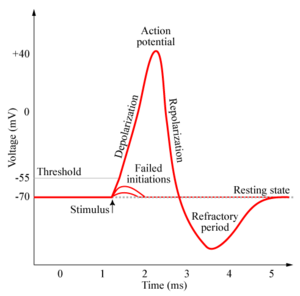
Resting Potential
-Resting Potential is potential difference across axon membrane when the axon is not transmitting impulse.
-At resting potential, axon membrane is polarised.
-Axoplasm is less 70mV compared to extracellular fluid.
-Na-K pump on axon membrane actively transport 3 Na+ ion out of axoplasm for every 2K+ transported into axoplasm for every completed cycle.
-Effectively, net one positive charge ion are transported out of axoplasm by Na-K pump in one complete cycle.
-Action of Na-K pumps maintain higher concentration of Na+ ion in extracellular fluid compared to axoplasm and higher concentration of K+ ion in axoplasm compared to extracellular fluid.
-Both Voltage-gated Na channels and Voltage-gated K chaneels are closed.
-Rate of Na+ diffusing into axoplasm through Na channels is lower compared to rate of K+ diffusing out of axoplasm through K channels.
-This is achived by having higher concentration of K+ channels on axon membrane compared to Na channels.
-Axoplasm also contains large size organic anions that increases negative charges present in axoplasm.
-All of these processes together maintains axon membranes at polarised state.
Action Potential
-When stimulus is received, a small amount of voltage-gated Na channels on axon membrane opened.
-Na+ ion from extracellular fluid diffuse into axoplasm through the opened gated channels leading to increase in potential difference across axon membrane.
-If the potential difference across axon membrane reaches threshold level, positive feedback occur to open more volatage-gated Na channel.
-Large quantity of Na+ ions diffuse into axoplasm through the opened channels.
-Axoplasm become more positively charge than extracellular fluid, depolarisation of axon membrane occurs.
-Action potential/impulse is generated.
-Impulse is a sudden change in polarised state of axon membrane into depolarised state that is caused by diffusion of Na+ ion into axoplasm through the opened voltage-gated Na channels.
Repolarisation
-The voltage-gated Na channels are closed while the voltage-gated K channels are opened.
-K+ ions diffuses out of axoplasm through the opened channels in large quantity, repolarisation of axon membrane occurs.
-The voltage-gated K channels are slow to close, too much K+ ions diffuse out of axoplasm, axoin membrane becomes hyper polarised.
-Through the action of Na-K pumps, resting potential is restored.
Refractory period- duration in which a new action potential cannot be generated.
Absolute refractory period- duration in which a new action potential cannot be generated however strong stimulus received. It occurs during repolarisation state.
Relative refractory period- duration in which a new action potential may be generated if stimulus of extraordinary strength is received by receptor. It occurs during restoration of resting potential.
Transmission of Impulse along axon
-Impulse is a sudden change in potential difference across axon membrane from polarized state into depolarized stated caused by diffusion of large amount of Na+ ions from extracellular fluid into axoplasm.
-During action potential in the 1st patch, diffusion of Na+ ions into axoplasm causes increase in Na+ concentration in the axoplasm of 1st patch of axon.
-Na+ ion in the axoplasm of 1st patch diffuse into axoplasm of 2nd patch.
-This causes increase in potential difference acrsoss axon membrane in the 2nd patch.
-Once the potential difference across axon membrane in the 2nd patch reaches threshold level, positive feedback occurs to open more voltage-gated Na channel in the 2nd patch..
-Diffusion of Na+ ions from extracellular fluid into axoplasm in the 2nd patch through the opened voltage-gated Na channels causes action potential/impulse in the 2nd patch.
-By the time action potential is generated in the 2nd patch, 1st patch is going through repolarisation and have reached resting potential.
-The processes are repeated from the 2nd patch to the subsequent patches through 'domino' effect.
-This ensures impulse is transmitted in one direction along axon.
Saltatory Conduction
In myelinated axon, action potential cannot be generated in region that contain myelin sheath.
Myelin sheath that are made of Schwann's cell acts as electrochemical insulatorr that prevents diffusion of Na+ and K+ ions across axon membraane.
Action Potential is only generated in Nodes of Ranvier along axon.
The impulse appears to jump from node of Ranvier to the next adjacent Node of Ranvier, saltatory conduction occur.
No comments:
Post a Comment